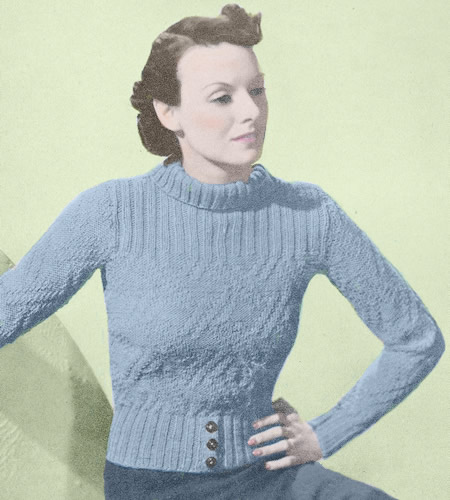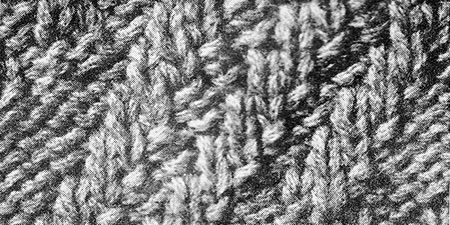Against the Cold

This 1930s sweater has good news and bad news. The good is that it's made in a yarn weight that is more popular today than then - that is a heavy DK or worsted. And as a consequence, the bad news is that the instructions are only given for one size, and with limited opportunity to alter the size by using thicker yarn.
I have referenced some reading material at the end of the instructions, that might help you with adaptations if you are feeling that adventurous.
" An unusual broken trellis pattern makes this warm country jumper. The casual polo collar does up at the back with three buttons, and the button-up idea is carried out again on the front of the welt. ".
Instructions.Instructions are given for only one small/medium size. BackWith No 8 needles, cast on 70 stitches and work 3½ inches in k2,
p2 rib. In the last row increase to 80 stitches by working twice into
each of the first and last 5 stitches of the row. Change to No. 7 needles
and pattern as follows: These 24 rows form the pattern, which is repeated throughout. Next row: Rib across the first 30 stitches, k6, turn, leaving remaining stitches on a spare needle. Work on these 36 stitches, keeping the 6 stitches at the inside edge in stocking-stitch, and after ½ an inch make a buttonhole as in the front welt (see instructions below). To make a buttonhole: When work measures 19 inches from commencement cast off 9 stitches at
the beginning of the following 2 alternate rows at the armhole edge, and
in the same row as the first casting-off make another buttonhole as before.
Return to the remaining 30 stitches, cast on 6 stitches and, keeping
these in stocking-stitch, work to correspond with the first side, but
omitting the buttonholes. Front:Begin with the right welt. 1st row: k6, *
p2, k2, repeat from * to last 2 stitches,
p2. Repeat these 2 rows once and then make a buttonhole as follows: Continue in pattern for 1 inch, and then make another buttonhole in the
same way, then work for 1 more inch and make another buttonhole. Now change to No 7 needles and pattern as for back, and continue until 3½ inches of the yoke ribbing have been done. Next row (right side facing): Rib
27, leave 12 stitches on a spare needle, rib 27. Cast off 9 stitches at the beginning of the following 2 alternate rows,
at the armhole edge. Sleeves:With No 8 needles, cast on 32 stitches and work in k2, p2 rib for 3 inches.
Now change to No 7 needles and pattern, but after 2 inches have been done, increase in the next and every following 4th row until there are 62 stitches on the needle, taking the increased stitches into the pattern. Work straight until sleeve measures 18½ inches from commencement,
then, cast off 4 stitches at the beginning of the next 2 rows, then k2tog
at each end of every row until 20 stitches remain. CollarJoin shoulder seams. With the set of No 8 needles and front of work facing, take the 18 stitches
from the spare needle at the left back, pick up and knit 19 over the left
shoulder, take 12 from the spare needle at the front, pick up and knit
19 over the right shoulder, and take the 18 from the spare needle at the
right back. To Make UpSew up side and sleeve seams, and insert sleeves. |
Materials
|
A word on the wool...This 1930s pattern is given in only one size - which to be fair is a "medium" although I suspect the average size for women is rather larger than medium these days. The original yarn was Patons Totem - which was a double knit weight but came in a number of guises over the years I believe - and the tension and needles indicate it's more like a worsted weight. So it's not so easy to simply increase the size by using a thicker yarn - it might work if you check your tension, but the resulting sweater might be unappealingly chunky for the intended style. Geraldine Warner has produced a helpful book about how to approach adapting
vintage patterns - however, don't be confused as it is published under
two different titles - but it's the same book. Also note that this
is a book of techniques and "how to" - it's does not contain
any knitting patterns: Whatever you choose to do, when adapting - always knit a swatch! Pattern detail:  |
